
| Trumpington Local History Group Trumpington Timeline: 1001 - 1500 |
| Copyright © Trumpington Local History Group, 2019. Updated 2 January 2019. Email: admin@trumpingtonlocalhistorygroup.org |
Edited by Andrew Roberts
Five hundred years in Trumpington's history: Medieval development,
including changes following the Norman conquest, the building of the
Church and the Black Death. One of a series of pages with Trumpington's
timeline.
Five hundred years in Trumpington's history: Medieval development,
including changes following the Norman conquest, the building of the
Church and the Black Death. One of a series of pages with Trumpington's
timeline.
1016
The English accepted the Danish Cnut (Canute) as their king.
Sources of information: Medieval London gallery, Museum of London.
The English accepted the Danish Cnut (Canute) as their king.
Sources of information: Medieval London gallery, Museum of London.
| Trumpington Parish Church. Photo: Andrew Roberts, October 2011. |
11th century
Trumpington was part of Thriplow Hundred, an
area stretching along the east bank of the River
Cam or Rhee from the Essex border to Cambridge.
The Hundred was known by this name before
1066, probably taking the name from a meeting
place at Thriplow itself. Other parishes in the
Hundred include Harston, Hauxton, Newton and
Little Shelford to the south west of Trumpington
and Great Shelford and Stapleford to the south
east. All the villages in the Hundred were nucleated
and the northern villages mostly developed near a
river crossing approach by a side street leading
from a main street parallel with the river, with a
church and manors in the intervening space.
Sources of information: Kirby, Tony and
Oosthuizen, Susan (eds.) (2000). An Atlas of
Cambridgeshire and Huntingdonshire History.
Cambridge: Anglia Polytechnic University. Map
31. The Victoria History of the Counties of
England (1982). A History of Cambridgeshire and
the Isle of Ely, Volume VIII. Armingford and
Thriplow Hundreds. Thriplow Hundred, pages
152-54.
Trumpington was part of Thriplow Hundred, an
area stretching along the east bank of the River
Cam or Rhee from the Essex border to Cambridge.
The Hundred was known by this name before
1066, probably taking the name from a meeting
place at Thriplow itself. Other parishes in the
Hundred include Harston, Hauxton, Newton and
Little Shelford to the south west of Trumpington
and Great Shelford and Stapleford to the south
east. All the villages in the Hundred were nucleated
and the northern villages mostly developed near a
river crossing approach by a side street leading
from a main street parallel with the river, with a
church and manors in the intervening space.
Sources of information: Kirby, Tony and
Oosthuizen, Susan (eds.) (2000). An Atlas of
Cambridgeshire and Huntingdonshire History.
Cambridge: Anglia Polytechnic University. Map
31. The Victoria History of the Counties of
England (1982). A History of Cambridgeshire and
the Isle of Ely, Volume VIII. Armingford and
Thriplow Hundreds. Thriplow Hundred, pages
152-54.
1085-86
King William commissioned the Domesday Survey in December 1085. The Commissioners held
an enquiry in Cambridge into the wealth of each Hundred in the county of 'Grentebrigscire'.
Following these enquiries, the evidence from the Survey was summarised in the Domesday
Book in 1086. It gives information about land ownership and occupation for 1066 and 1086.
The account of 'Grentebrige' (Cambridge) is limited, but shows that it was already an important
town, assessed as a separate Hundred made up of ten wards.
The sites of the villages in the area have been consistent since Domesday.
Trumpington is referred to as 'Trumpinton/Trumpintone' and consisted of 37 households (about
185 people including 33 peasants and 4 slaves), with four manors. A mill at Trumpington was
held by William de Warenne. There was a weir rendering 450 eels and pasture for the cattle of
the vill.
Sources of information: The National Archives, Domesday, catalogue reference E 31/2/1. PASE
database (Prosopography of Anglo-Saxon England). Darby, H.C. (1971). The Domesday
Geography of Eastern England. 3rd edition. Cambridge: Cambridge University Press. Gray,
E.A. (1977). Hobson's Conduit, the Story of a Cambridgeshire Chalk Stream. Page 17. Kirby,
Tony and Oosthuizen, Susan (eds.) (2000). An Atlas of Cambridgeshire and Huntingdonshire
History. Cambridge: Anglia Polytechnic University. Map 34. Morris, John (editor) (1981).
Domesday Book. A Survey of the Counties of England, compiled by Direction of King William
I, Winchester 1086. Chichester: Philimore. Taylor, Alison (1999). Cambridge: the Hidden
History. Pages 127. The Victoria History of the Counties of England (1938). The History of the
County of Cambridge & the Isle of Ely. Volume I. Pages 335-414. The Victoria History of the
Counties of England (1948). The History of the County of Cambridge & the Isle of Ely.
Volume II. Page 50. The Victoria History of the Counties of England (1959). The History of the
County of Cambridge & the Isle of Ely. Volume III. The City and University of Cambridge.
Medieval Cambridge, page 3-5.The Victoria History of the Counties of England (1973). The
History of the County of Cambridge & the Isle of Ely. Volume V. Grantchester, page 208. The
Victoria History of the Counties of England (1982). A History of Cambridgeshire and the Isle
of Ely, Volume VIII. Armingford and Thriplow Hundreds. Trumpington, page 249.
King William commissioned the Domesday Survey in December 1085. The Commissioners held
an enquiry in Cambridge into the wealth of each Hundred in the county of 'Grentebrigscire'.
Following these enquiries, the evidence from the Survey was summarised in the Domesday
Book in 1086. It gives information about land ownership and occupation for 1066 and 1086.
The account of 'Grentebrige' (Cambridge) is limited, but shows that it was already an important
town, assessed as a separate Hundred made up of ten wards.
The sites of the villages in the area have been consistent since Domesday.
Trumpington is referred to as 'Trumpinton/Trumpintone' and consisted of 37 households (about
185 people including 33 peasants and 4 slaves), with four manors. A mill at Trumpington was
held by William de Warenne. There was a weir rendering 450 eels and pasture for the cattle of
the vill.
Sources of information: The National Archives, Domesday, catalogue reference E 31/2/1. PASE
database (Prosopography of Anglo-Saxon England). Darby, H.C. (1971). The Domesday
Geography of Eastern England. 3rd edition. Cambridge: Cambridge University Press. Gray,
E.A. (1977). Hobson's Conduit, the Story of a Cambridgeshire Chalk Stream. Page 17. Kirby,
Tony and Oosthuizen, Susan (eds.) (2000). An Atlas of Cambridgeshire and Huntingdonshire
History. Cambridge: Anglia Polytechnic University. Map 34. Morris, John (editor) (1981).
Domesday Book. A Survey of the Counties of England, compiled by Direction of King William
I, Winchester 1086. Chichester: Philimore. Taylor, Alison (1999). Cambridge: the Hidden
History. Pages 127. The Victoria History of the Counties of England (1938). The History of the
County of Cambridge & the Isle of Ely. Volume I. Pages 335-414. The Victoria History of the
Counties of England (1948). The History of the County of Cambridge & the Isle of Ely.
Volume II. Page 50. The Victoria History of the Counties of England (1959). The History of the
County of Cambridge & the Isle of Ely. Volume III. The City and University of Cambridge.
Medieval Cambridge, page 3-5.The Victoria History of the Counties of England (1973). The
History of the County of Cambridge & the Isle of Ely. Volume V. Grantchester, page 208. The
Victoria History of the Counties of England (1982). A History of Cambridgeshire and the Isle
of Ely, Volume VIII. Armingford and Thriplow Hundreds. Trumpington, page 249.
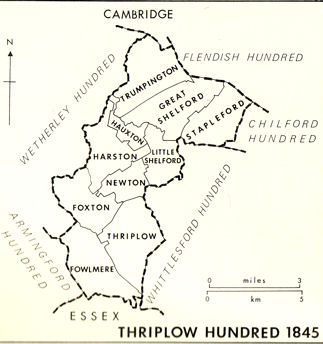
| Map of the Thriplow Hundred. From The Victoria History of the Counties of England (1982). A History of Cambridgeshire and the Isle of Ely, Volume VIII. Armingford and Thriplow Hundreds. Page 253. |
1066
After the Norman invasion: the area was quickly taken by the Normans. In 1068, William I
visited Cambridge and ordered the construction of a castle. Picot was the sheriff of Cambridge
from 1070-92. The settlement pattern was one of continuity rather than change.
Sources of information: Dr Sam Newton, Cambridge and the Kingdom of East Anglia,
Institute of Continuing Education, University of Cambridge, November 2009. History of
Cambridge University, Web page [accessed 14 December 2010]. Kirby, Tony and Oosthuizen,
Susan (eds.) (2000). An Atlas of Cambridgeshire and Huntingdonshire History. Cambridge:
Anglia Polytechnic University. Map 33. Taylor, Alison (1999). Cambridge: the Hidden
History. Pages 51-59. The Victoria History of the Counties of England (1959). The History of
the County of Cambridge & the Isle of Ely. Volume III. The City and University of
Cambridge. Medieval Cambridge, page 5 and Public Buildings, page 116-18.
After the Norman invasion: the area was quickly taken by the Normans. In 1068, William I
visited Cambridge and ordered the construction of a castle. Picot was the sheriff of Cambridge
from 1070-92. The settlement pattern was one of continuity rather than change.
Sources of information: Dr Sam Newton, Cambridge and the Kingdom of East Anglia,
Institute of Continuing Education, University of Cambridge, November 2009. History of
Cambridge University, Web page [accessed 14 December 2010]. Kirby, Tony and Oosthuizen,
Susan (eds.) (2000). An Atlas of Cambridgeshire and Huntingdonshire History. Cambridge:
Anglia Polytechnic University. Map 33. Taylor, Alison (1999). Cambridge: the Hidden
History. Pages 51-59. The Victoria History of the Counties of England (1959). The History of
the County of Cambridge & the Isle of Ely. Volume III. The City and University of
Cambridge. Medieval Cambridge, page 5 and Public Buildings, page 116-18.
1042-57
The English prince Edward (the Confessor) regained the throne. King Edward gave a charter to
the monks of Ely on all the properties that the church owned, including land outside the Isle in
Trumpington [named Trumpentune, Trumpintune].
Sources of information: Liber Eliensis. A History of the Isle of Ely from the Seventh Century
to the Twelfth, Compiled by a Monk of Ely the Twelfth Century. Translated by Janet
Fairweather (2005). Woodbridge: Boydell Press. Page 191.
The English prince Edward (the Confessor) regained the throne. King Edward gave a charter to
the monks of Ely on all the properties that the church owned, including land outside the Isle in
Trumpington [named Trumpentune, Trumpintune].
Sources of information: Liber Eliensis. A History of the Isle of Ely from the Seventh Century
to the Twelfth, Compiled by a Monk of Ely the Twelfth Century. Translated by Janet
Fairweather (2005). Woodbridge: Boydell Press. Page 191.
11th-16th centuries
There was a complex pattern of Medieval manors in Trumpington.
One manor was held by the Trumpington family from the 12th to the 16th centuries. It was
later sold to the Pychard family then the Pemberton family. The original hall may have been a
13th century manor house on the same site as the current hall.
Another manor was the land given to Ely Abbey by Ealdorman Beorhtnoth in 991. In 1066, the
Domesday Survey recorded that 4½ hides (about 500 acres) were held by the Abbey by the
thegn Tochi. A 'thegn' (thane) was an aristocratic retainer of the king or a nobleman.
'Thegnland' was a type of landholding like a tenure limited to a single lifetime: the land remained
owned by the Abbey with the landholder owing some sort of service to the Abbey. Tochi was
described as a great king's thegn. This land was seized by a Norman lord, Frederick de
Warenne, and later held by the de Cailly family. It was sold to the Pychard family in the 16th
century.
A third manor was near the church before 1279, later rebuilt as Anstey Hall.
Sources of information: Farrer, William (1920). Feudal Cambridgeshire. Cambridge: University
Press. Pages 219-23. Lysons, Daniel and Lysons, Samuel (1808). Magna Britannia.
Cambridgeshire. Republished 1978. Wakefield: EP Publishing. Pages 269-70. Miller, Edward
(1951). The Abbey and Bishopric of Ely. Cambridge: CUP. Pages 52-53. Taylor, Alison
(1999). Cambridge: the Hidden History. Pages 127-30. The Victoria History of the Counties
of England (1982). A History of Cambridgeshire and the Isle of Ely, Volume VIII. Armingford
and Thriplow Hundreds. Trumpington, page 251-57.
There was a complex pattern of Medieval manors in Trumpington.
One manor was held by the Trumpington family from the 12th to the 16th centuries. It was
later sold to the Pychard family then the Pemberton family. The original hall may have been a
13th century manor house on the same site as the current hall.
Another manor was the land given to Ely Abbey by Ealdorman Beorhtnoth in 991. In 1066, the
Domesday Survey recorded that 4½ hides (about 500 acres) were held by the Abbey by the
thegn Tochi. A 'thegn' (thane) was an aristocratic retainer of the king or a nobleman.
'Thegnland' was a type of landholding like a tenure limited to a single lifetime: the land remained
owned by the Abbey with the landholder owing some sort of service to the Abbey. Tochi was
described as a great king's thegn. This land was seized by a Norman lord, Frederick de
Warenne, and later held by the de Cailly family. It was sold to the Pychard family in the 16th
century.
A third manor was near the church before 1279, later rebuilt as Anstey Hall.
Sources of information: Farrer, William (1920). Feudal Cambridgeshire. Cambridge: University
Press. Pages 219-23. Lysons, Daniel and Lysons, Samuel (1808). Magna Britannia.
Cambridgeshire. Republished 1978. Wakefield: EP Publishing. Pages 269-70. Miller, Edward
(1951). The Abbey and Bishopric of Ely. Cambridge: CUP. Pages 52-53. Taylor, Alison
(1999). Cambridge: the Hidden History. Pages 127-30. The Victoria History of the Counties
of England (1982). A History of Cambridgeshire and the Isle of Ely, Volume VIII. Armingford
and Thriplow Hundreds. Trumpington, page 251-57.
c. 1200
Initial phase of building the current
Trumpington Parish Church: the base of the
west respond of the south arcade survives
from this date. The church was originally
dedicated to St Nicholas.
Sources of information: Ambrose, Tom
(2006). St Mary & St Michael Trumpington.
Hicks, Carola (ed.) (1997). Cambridgeshire
Churches. Stamford: Paul Watkins for
Cambridgeshire Historic Churches Trust.
Pages 63-64, 91. Pevsner, Nicholas (1970).
Cambridgeshire. The Buildings of England.
Royal Commission on Historical Monuments
(England) (1959). An Inventory of the
Historical Monuments in the City of
Cambridge. Part II. London: HMSO. Page
294-98. The Victoria History of the Counties
of England (1982). A History of
Cambridgeshire and the Isle of Ely, Volume
VIII. Armingford and Thriplow Hundreds.
Trumpington, page 262.
Local History Group web page: Introduction
and History of the Parish Church.
Initial phase of building the current
Trumpington Parish Church: the base of the
west respond of the south arcade survives
from this date. The church was originally
dedicated to St Nicholas.
Sources of information: Ambrose, Tom
(2006). St Mary & St Michael Trumpington.
Hicks, Carola (ed.) (1997). Cambridgeshire
Churches. Stamford: Paul Watkins for
Cambridgeshire Historic Churches Trust.
Pages 63-64, 91. Pevsner, Nicholas (1970).
Cambridgeshire. The Buildings of England.
Royal Commission on Historical Monuments
(England) (1959). An Inventory of the
Historical Monuments in the City of
Cambridge. Part II. London: HMSO. Page
294-98. The Victoria History of the Counties
of England (1982). A History of
Cambridgeshire and the Isle of Ely, Volume
VIII. Armingford and Thriplow Hundreds.
Trumpington, page 262.
Local History Group web page: Introduction
and History of the Parish Church.
1209
Cambridge University was founded in 1209. In the early decades, students lived in lodgings and
then in hostels; there were no colleges.
Sources of information: History of Cambridge University web site [accessed 14 December
2010]. Darby, H.C. (1971). The Domesday Geography of Eastern England. 3rd edition.
Cambridge: Cambridge University Press. Pages 37-40.
Cambridge University was founded in 1209. In the early decades, students lived in lodgings and
then in hostels; there were no colleges.
Sources of information: History of Cambridge University web site [accessed 14 December
2010]. Darby, H.C. (1971). The Domesday Geography of Eastern England. 3rd edition.
Cambridge: Cambridge University Press. Pages 37-40.
1220
First Rector (Hendricus) and Vicar (Ioce or Jocius) of
Trumpington Parish Church.
Sources of information: Panel in Church.
Local History Group web page: Parish Church: Vicars and
Rectors.
First Rector (Hendricus) and Vicar (Ioce or Jocius) of
Trumpington Parish Church.
Sources of information: Panel in Church.
Local History Group web page: Parish Church: Vicars and
Rectors.
1289
Death of Sir Roger de Trumpington (see 1320s for the memorial brass).
Sources of information: Ambrose, Tom (2006). St Mary & St Michael Trumpington. Carr,
Edith (1968), The Story of Trumpington Church . Pevsner, Nicholas (1970). Cambridgeshire.
The Buildings of England. The Victoria History of the Counties of England (1982). A History
of Cambridgeshire and the Isle of Ely, Volume VIII. Armingford and Thriplow Hundreds.
Trumpington, page 253.
Death of Sir Roger de Trumpington (see 1320s for the memorial brass).
Sources of information: Ambrose, Tom (2006). St Mary & St Michael Trumpington. Carr,
Edith (1968), The Story of Trumpington Church . Pevsner, Nicholas (1970). Cambridgeshire.
The Buildings of England. The Victoria History of the Counties of England (1982). A History
of Cambridgeshire and the Isle of Ely, Volume VIII. Armingford and Thriplow Hundreds.
Trumpington, page 253.
1264-66
Trumpington and other villages raided by supporters of Simon de Montfort.
Sources of information: Taylor, Alison (1999). Cambridge: the Hidden History. Pages 75, 127.
Trumpington and other villages raided by supporters of Simon de Montfort.
Sources of information: Taylor, Alison (1999). Cambridge: the Hidden History. Pages 75, 127.
1279
The Hundred Rolls include details of Cambridge, where university students were still living in
hostels rather than colleges. The population of Trumpington had increased to around 100
landowners (nearly 80 houses and cottages).
Sources of information: Darby, H.C. (1971). The Domesday Geography of Eastern England.
3rd edition. Cambridge: Cambridge University Press. Pages 37-40. Taylor, Alison (1999).
Cambridge: the Hidden History. Page 127. The Victoria History of the Counties of England
(1982). A History of Cambridgeshire and the Isle of Ely, Volume VIII. Armingford and
Thriplow Hundreds. Trumpington, page 249.
The Hundred Rolls include details of Cambridge, where university students were still living in
hostels rather than colleges. The population of Trumpington had increased to around 100
landowners (nearly 80 houses and cottages).
Sources of information: Darby, H.C. (1971). The Domesday Geography of Eastern England.
3rd edition. Cambridge: Cambridge University Press. Pages 37-40. Taylor, Alison (1999).
Cambridge: the Hidden History. Page 127. The Victoria History of the Counties of England
(1982). A History of Cambridgeshire and the Isle of Ely, Volume VIII. Armingford and
Thriplow Hundreds. Trumpington, page 249.
1327
The Lay Subsidy was a tax levied by the Crown on the value of moveable goods (farm
equipment, large domestic animals, surplus crops, etc.). The 1327 Subsidy listed every taxpayer
by name and the amount payable. The list for Trumpington named 48 taxpayers, including
Egidio de Trumpeton, Johe Arnold and Thomas Chapman. Once the total liability for each area
was established, it was used as the basis for taxation for the next 300 years.
Sources of information: Hesse, Mary (2000). 'The Lay Subsidy of 1327'. In Kirby, Tony and
Oosthuizen, Susan (eds.) (2000). An Atlas of Cambridgeshire and Huntingdonshire History.
Cambridge: Anglia Polytechnic University. Map 36. Muskett, J.J. (1903-08). Lay Subsidy for
the Year 1327, Cambridgeshire and Isle of Ely. : The East Anglian. Trumpington, pages 36-37.
The Victoria History of the Counties of England (1982). A History of Cambridgeshire and the
Isle of Ely, Volume VIII. Armingford and Thriplow Hundreds. Trumpington, page 249.
The Lay Subsidy was a tax levied by the Crown on the value of moveable goods (farm
equipment, large domestic animals, surplus crops, etc.). The 1327 Subsidy listed every taxpayer
by name and the amount payable. The list for Trumpington named 48 taxpayers, including
Egidio de Trumpeton, Johe Arnold and Thomas Chapman. Once the total liability for each area
was established, it was used as the basis for taxation for the next 300 years.
Sources of information: Hesse, Mary (2000). 'The Lay Subsidy of 1327'. In Kirby, Tony and
Oosthuizen, Susan (eds.) (2000). An Atlas of Cambridgeshire and Huntingdonshire History.
Cambridge: Anglia Polytechnic University. Map 36. Muskett, J.J. (1903-08). Lay Subsidy for
the Year 1327, Cambridgeshire and Isle of Ely. : The East Anglian. Trumpington, pages 36-37.
The Victoria History of the Counties of England (1982). A History of Cambridgeshire and the
Isle of Ely, Volume VIII. Armingford and Thriplow Hundreds. Trumpington, page 249.
Late 13th - early 14th century
Most of the structure of the current Trumpington
Parish Church dates from the early 14th century,
starting with the west tower and chancel c. 1300 then
the nave early 14th century. Carola Hicks comments
that the splendid churches in the villages around
Cambridge reflect the growing prosperity of the
intellectual centre.
The Church would have been enhanced by stained
glass. Most of the glass depicting saints and biblical
figures was destroyed during the Reformation, but
examples with heraldic motifs and purely decorative
areas have survived and are in south and west
windows of the chancel.
Sources of information: Trumpington Parish Church
Web site. The Corpus Vitrearum Medii Aevi
(CVMA) Web site about Medieval stained glass.
Ambrose, Tom (2006). St Mary & St Michael
Trumpington. Hicks, Carola (ed.) (1997).
Cambridgeshire Churches. Stamford: Paul Watkins
for Cambridgeshire Historic Churches Trust. Pages
63-64, 91, 276-77. Pevsner, Nicholas (1970).
Cambridgeshire. The Buildings of England. Royal
Commission on Historical Monuments (England)
(1959). An Inventory of the Historical Monuments
in the City of Cambridge. Part II. London: HMSO.
Page 294-98. The Victoria History of the Counties of
England (1982). A History of Cambridgeshire and
the Isle of Ely, Volume VIII. Armingford and
Thriplow Hundreds. Trumpington, page 264-65.
Local History Group web page: Introduction and
History of the Parish Church.
Most of the structure of the current Trumpington
Parish Church dates from the early 14th century,
starting with the west tower and chancel c. 1300 then
the nave early 14th century. Carola Hicks comments
that the splendid churches in the villages around
Cambridge reflect the growing prosperity of the
intellectual centre.
The Church would have been enhanced by stained
glass. Most of the glass depicting saints and biblical
figures was destroyed during the Reformation, but
examples with heraldic motifs and purely decorative
areas have survived and are in south and west
windows of the chancel.
Sources of information: Trumpington Parish Church
Web site. The Corpus Vitrearum Medii Aevi
(CVMA) Web site about Medieval stained glass.
Ambrose, Tom (2006). St Mary & St Michael
Trumpington. Hicks, Carola (ed.) (1997).
Cambridgeshire Churches. Stamford: Paul Watkins
for Cambridgeshire Historic Churches Trust. Pages
63-64, 91, 276-77. Pevsner, Nicholas (1970).
Cambridgeshire. The Buildings of England. Royal
Commission on Historical Monuments (England)
(1959). An Inventory of the Historical Monuments
in the City of Cambridge. Part II. London: HMSO.
Page 294-98. The Victoria History of the Counties of
England (1982). A History of Cambridgeshire and
the Isle of Ely, Volume VIII. Armingford and
Thriplow Hundreds. Trumpington, page 264-65.
Local History Group web page: Introduction and
History of the Parish Church.
1314
Trumpington Feast was founded by charter, to take place on 1 August (in the 19th century, this
changed to the eve, day and morrow of St Peter & St Paul, 28-30 June).
Sources of information: The Victoria History of the Counties of England (1982). A History of
Cambridgeshire and the Isle of Ely, Volume VIII. Armingford and Thriplow Hundreds.
Trumpington, page 251.
Local History Group web page: Trumpington Charter Fair, 1968.
Trumpington Feast was founded by charter, to take place on 1 August (in the 19th century, this
changed to the eve, day and morrow of St Peter & St Paul, 28-30 June).
Sources of information: The Victoria History of the Counties of England (1982). A History of
Cambridgeshire and the Isle of Ely, Volume VIII. Armingford and Thriplow Hundreds.
Trumpington, page 251.
Local History Group web page: Trumpington Charter Fair, 1968.
1320s
A monument to the Trumpington family was placed
between the north aisle and north chapel of the Parish
Church, probably in the late 1320s. This is a table-tomb
under an ogee arch, with a memorial brass set in a slab of
Purbeck marble on its upper surface. The brass is 6ft 4in
long and shows an effigy thought to be of a crusader, a
knight in mail armour and surcoat, with feet resting on a
dog, with a sword and shield charged with the arms of
Trumpington. The brass is thought to date from the
1320s and may be the second oldest surviving military
brass in England. The brass is often ascribed to Sir Roger
de Trumpington (died 1289) but assessments by the
Royal Commission on Historical Monuments (1959),
eminent archaeologist Denys Spittle (1970) and the
Victoria County History (1982) concluded that its history
was more complex. Spittle argued that the brass may
originally have been designed for Sir Roger's son, Giles
de Trumpington (died between 1327 and 1332), then
altered in devotion to Giles's son who predeceased him,
Roger de Trumpington (died 1326). The tomb has clunch
sides, with the south side altered by the insertion of
memorial tablets to Thomas Pytcher and William Pitcher
(1577 and 1614).
Sources of information: Ambrose, Tom (2006). St Mary
& St Michael Trumpington. Carr, Edith (1968). The
Story of Trumpington Church. Hicks, Carola (ed.)
(1997). Cambridgeshire Churches. Stamford: Paul
Watkins for Cambridgeshire Historic Churches Trust.
Pages 303-04. Lysons, Daniel and Lysons, Samuel
(1808). Magna Britannia. Cambridgeshire. Republished
1978. Wakefield: EP Publishing. Page 65. Moule, A.C.
(1922). 'Some Trumpington Inscriptions, with Special
Reference to the Base of the Old Village Cross',
Proceedings of the Cambridge Antiquarian Society, 24,
p. 95-109. Pevsner, Nicholas (1970). Cambridgeshire.
The Buildings of England. Royal Commission on
Historical Monuments (England) (1959). An Inventory of
the Historical Monuments in the City of Cambridge.
Part II. London: HMSO. Page 297. Spittle, S.D.T.
(1970). 'The Trumpington Brass', Archaeological
Journal, 127, p. 223-27.
Local History Group web page: History of the Parish
Church.
A monument to the Trumpington family was placed
between the north aisle and north chapel of the Parish
Church, probably in the late 1320s. This is a table-tomb
under an ogee arch, with a memorial brass set in a slab of
Purbeck marble on its upper surface. The brass is 6ft 4in
long and shows an effigy thought to be of a crusader, a
knight in mail armour and surcoat, with feet resting on a
dog, with a sword and shield charged with the arms of
Trumpington. The brass is thought to date from the
1320s and may be the second oldest surviving military
brass in England. The brass is often ascribed to Sir Roger
de Trumpington (died 1289) but assessments by the
Royal Commission on Historical Monuments (1959),
eminent archaeologist Denys Spittle (1970) and the
Victoria County History (1982) concluded that its history
was more complex. Spittle argued that the brass may
originally have been designed for Sir Roger's son, Giles
de Trumpington (died between 1327 and 1332), then
altered in devotion to Giles's son who predeceased him,
Roger de Trumpington (died 1326). The tomb has clunch
sides, with the south side altered by the insertion of
memorial tablets to Thomas Pytcher and William Pitcher
(1577 and 1614).
Sources of information: Ambrose, Tom (2006). St Mary
& St Michael Trumpington. Carr, Edith (1968). The
Story of Trumpington Church. Hicks, Carola (ed.)
(1997). Cambridgeshire Churches. Stamford: Paul
Watkins for Cambridgeshire Historic Churches Trust.
Pages 303-04. Lysons, Daniel and Lysons, Samuel
(1808). Magna Britannia. Cambridgeshire. Republished
1978. Wakefield: EP Publishing. Page 65. Moule, A.C.
(1922). 'Some Trumpington Inscriptions, with Special
Reference to the Base of the Old Village Cross',
Proceedings of the Cambridge Antiquarian Society, 24,
p. 95-109. Pevsner, Nicholas (1970). Cambridgeshire.
The Buildings of England. Royal Commission on
Historical Monuments (England) (1959). An Inventory of
the Historical Monuments in the City of Cambridge.
Part II. London: HMSO. Page 297. Spittle, S.D.T.
(1970). 'The Trumpington Brass', Archaeological
Journal, 127, p. 223-27.
Local History Group web page: History of the Parish
Church.
1300 - c. 1450
The Cambridge area was among the most densely settled and wealthy regions in the country in
the late 13th and 14th centuries. However, the parishes to the south of Cambridge contracted in
population from around 1330, with arable land going out of cultivation. There were episodes of
Black Death in 1348-50 and the 1360s and 1370s. Great Shelford was severely affected by
plague in 1361.
Sources of information: Darby, H.C. (1971). The Domesday Geography of Eastern England.
3rd edition. Cambridge: Cambridge University Press. Pages 16-17. Spufford, Margaret (2000).
Contrasting Communities. English Villagers in the Sixteenth and Seventeeth Centuries.
Stroud: Sutton Publishing. Pages 4-10.
The Cambridge area was among the most densely settled and wealthy regions in the country in
the late 13th and 14th centuries. However, the parishes to the south of Cambridge contracted in
population from around 1330, with arable land going out of cultivation. There were episodes of
Black Death in 1348-50 and the 1360s and 1370s. Great Shelford was severely affected by
plague in 1361.
Sources of information: Darby, H.C. (1971). The Domesday Geography of Eastern England.
3rd edition. Cambridge: Cambridge University Press. Pages 16-17. Spufford, Margaret (2000).
Contrasting Communities. English Villagers in the Sixteenth and Seventeeth Centuries.
Stroud: Sutton Publishing. Pages 4-10.
1419
King Henry V used English in written instructions, the first time for 300 years that it had taken
precedence over French in government documents.
Sources of information: Evolving English: One Language, Many Voices, exhibition at the
British Library, 2010-11.
King Henry V used English in written instructions, the first time for 300 years that it had taken
precedence over French in government documents.
Sources of information: Evolving English: One Language, Many Voices, exhibition at the
British Library, 2010-11.
c. 1390
Geoffrey Chaucer (c. 1340-1400) writes The Canterbury Tales. His wife was a friend of Lady
Blanche de Trumpington and he may have known the village. Chaucer's 'The Reeve's Tale' is
thought to be based on a mill in or near Trumpington:
"At Trumpington, not fer fro Cantebridge,
There goth a brook, and over that a bridge,
Upon the whiche brook there stant a melle"
(The Canterbury Tales, Penguin Popular Classics)
Trumpington mill belonged in the 13th century to the Trumpington family, held as successors to
the Caylys, who had inherited the mill held in 1086 by William de Warenne, but Chaucer's
reference may be to Hauxton Mill: this was more likely to be the mill used as a model by
Chaucer.
Sources of information: Evolving English: One Language, Many Voices, exhibition at the
British Library, 2010-11. Gray, Douglas (2004). 'Chaucer, Geoffrey (c.1340-1400)', Oxford
Dictionary of National Biography, Oxford University Press. Taylor, Alison (1999). Cambridge:
the Hidden History. Page 130. The Victoria History of the Counties of England (1973). The
History of the County of Cambridge & the Isle of Ely. Volume V. Grantchester, page 208. The
Victoria History of the Counties of England (1982). A History of Cambridgeshire and the Isle
of Ely, Volume VIII. Armingford and Thriplow Hundreds. Hauxton and Newton, page 201.
Geoffrey Chaucer (c. 1340-1400) writes The Canterbury Tales. His wife was a friend of Lady
Blanche de Trumpington and he may have known the village. Chaucer's 'The Reeve's Tale' is
thought to be based on a mill in or near Trumpington:
"At Trumpington, not fer fro Cantebridge,
There goth a brook, and over that a bridge,
Upon the whiche brook there stant a melle"
(The Canterbury Tales, Penguin Popular Classics)
Trumpington mill belonged in the 13th century to the Trumpington family, held as successors to
the Caylys, who had inherited the mill held in 1086 by William de Warenne, but Chaucer's
reference may be to Hauxton Mill: this was more likely to be the mill used as a model by
Chaucer.
Sources of information: Evolving English: One Language, Many Voices, exhibition at the
British Library, 2010-11. Gray, Douglas (2004). 'Chaucer, Geoffrey (c.1340-1400)', Oxford
Dictionary of National Biography, Oxford University Press. Taylor, Alison (1999). Cambridge:
the Hidden History. Page 130. The Victoria History of the Counties of England (1973). The
History of the County of Cambridge & the Isle of Ely. Volume V. Grantchester, page 208. The
Victoria History of the Counties of England (1982). A History of Cambridgeshire and the Isle
of Ely, Volume VIII. Armingford and Thriplow Hundreds. Hauxton and Newton, page 201.
1446-1515
Building of King's College Chapel.
Sources of information: Pevsner, Nicholas
(1970). Cambridgeshire. The Buildings of
England.
Building of King's College Chapel.
Sources of information: Pevsner, Nicholas
(1970). Cambridgeshire. The Buildings of
England.
15th century
There was no fighting in the Cambridge area during the War of the Roses.
Sources of information: The Victoria History of the Counties of England (1959). The History of
the County of Cambridge & the Isle of Ely. Volume III. The City and University of
Cambridge. Medieval Cambridge, page 13.
There was no fighting in the Cambridge area during the War of the Roses.
Sources of information: The Victoria History of the Counties of England (1959). The History of
the County of Cambridge & the Isle of Ely. Volume III. The City and University of
Cambridge. Medieval Cambridge, page 13.
15th century
The Green Man public house in Trumpington was
originally a 15th century timber-framed hall-house.
Sources of information: The Victoria History of the
Counties of England (1982). A History of
Cambridgeshire and the Isle of Ely, Volume VIII.
Armingford and Thriplow Hundreds. Trumpington,
page 250.
Local History Group web page: The Green Man
public house.
The Green Man public house in Trumpington was
originally a 15th century timber-framed hall-house.
Sources of information: The Victoria History of the
Counties of England (1982). A History of
Cambridgeshire and the Isle of Ely, Volume VIII.
Armingford and Thriplow Hundreds. Trumpington,
page 250.
Local History Group web page: The Green Man
public house.
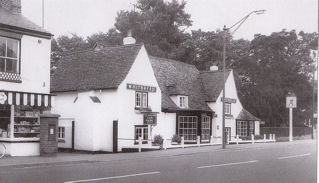
| The Green Man, late 1960s. Source: Cambridgeshire Collection, Cambridge Central Library. Reproduced in Trumpington Past & Present, p. 68. |
c. 1480
A village cross was erected after 1476 on
'Cross Hill', where Church Lane joins the High
Street. The Barnack stone base of the cross
had a socket for a wooden shaft and the
inscription "Orate pro animab[us] Joh[ann]is
Stokton et Agnetis uxoris ei[us]" [Pray for the
souls of John Stokton and of Agnes his wife].
John and Agnes Stokton probably lived in a
house on the north west side of Church Lane
(in the area now occupied by the Unicorn
pub). Stokton may have been a farmer (in the
16th century, there was a Stokton Farm of
100 acres). John Stokton was referred to in
the Subsidy Rolls in 1450 but had died before
1476.
The placing of the cross at the 'Cross Hill'
location suggests that the focus of the village
may have moved from the area around the
Church to this more north easterly area by the
15th century.
The base was rediscovered during the erection
of the War Memorial on 17 August 1921. It
was given to the Parish Church and is now
under the Church tower.
Sources of information: see the Cross Hill page.
Local History Group web pages: John and
Agnes Stokton; Cross Hill.
A village cross was erected after 1476 on
'Cross Hill', where Church Lane joins the High
Street. The Barnack stone base of the cross
had a socket for a wooden shaft and the
inscription "Orate pro animab[us] Joh[ann]is
Stokton et Agnetis uxoris ei[us]" [Pray for the
souls of John Stokton and of Agnes his wife].
John and Agnes Stokton probably lived in a
house on the north west side of Church Lane
(in the area now occupied by the Unicorn
pub). Stokton may have been a farmer (in the
16th century, there was a Stokton Farm of
100 acres). John Stokton was referred to in
the Subsidy Rolls in 1450 but had died before
1476.
The placing of the cross at the 'Cross Hill'
location suggests that the focus of the village
may have moved from the area around the
Church to this more north easterly area by the
15th century.
The base was rediscovered during the erection
of the War Memorial on 17 August 1921. It
was given to the Parish Church and is now
under the Church tower.
Sources of information: see the Cross Hill page.
Local History Group web pages: John and
Agnes Stokton; Cross Hill.
13th century
By the 13th century, there was a tollgate
called 'Trumpington Gate' or 'Trumpington
Gates' on the south side of Cambridge, on the
road to Trumpington. This was adjacent to St
Botolph's Church and the 'King's Ditch' which
circled the south and east of the town. (There
was a second gate called 'Barnwell Gate' to
the east, near the present Great St Andrew's
Church.)
St Botolph was the patron saint of travellers
and churches dedicated to him were
sometimes found at or near city gates. Writing
in 1908, Rev. H.P. Stokes was not able to
establish when the Trumpington Gates were
first set up, but they predate 1266. Stokes
says that there is an allusion to them in a
document in Corpus Christi College Archives
and the use of the plural is assumed to refer to
double gates.
Stokes argued that there were dwellings
beyond the Ditch in the 13th century and
produced a possible plan of the area. The
parishes of St Botolph and St Benet were
partly located outside the King's Ditch while St
Peter's parish ('St Peter without the
Trumpington Gates', later 'St Mary the Less')
extended south of the Ditch to the boundary
with Trumpington. Stokes gives details of the
owners and occupants of properties outside
the gates from the 13th century, including
ownership by the Cayley's of Trumpington.
Peterhouse was founded by the Bishop of Ely
in 1284.
Stokes adds that as late as the 18th century,
the high street through Cambridge up to the
junction with Bridge Street was occasionally
called Trumpington Road.
Sources of information: National Monuments
Record web site [accessed 22 December
2010]. St Botolph's Church Web site
[accessed 23 December 2010]. Kirby, Tony
and Oosthuizen, Susan (eds.) (2000). An Atlas
of Cambridgeshire and Huntingdonshire
History. Cambridge: Anglia Polytechnic
University. Map 55. Stokes, H.P. (1908).
Outside the Trumpington Gates Before
Peterhouse was Founded. Cambridge:
Cambridgeshire Antiquarian Society. Taylor,
Alison (1999). Cambridge: the Hidden
History. Pages 45-49, 86. The Victoria
History of the Counties of England (1959).
The History of the County of Cambridge &
the Isle of Ely. Volume III. The City and
University of Cambridge. Medieval
Cambridge, page 3 and Growth of the City,
page 110.
By the 13th century, there was a tollgate
called 'Trumpington Gate' or 'Trumpington
Gates' on the south side of Cambridge, on the
road to Trumpington. This was adjacent to St
Botolph's Church and the 'King's Ditch' which
circled the south and east of the town. (There
was a second gate called 'Barnwell Gate' to
the east, near the present Great St Andrew's
Church.)
St Botolph was the patron saint of travellers
and churches dedicated to him were
sometimes found at or near city gates. Writing
in 1908, Rev. H.P. Stokes was not able to
establish when the Trumpington Gates were
first set up, but they predate 1266. Stokes
says that there is an allusion to them in a
document in Corpus Christi College Archives
and the use of the plural is assumed to refer to
double gates.
Stokes argued that there were dwellings
beyond the Ditch in the 13th century and
produced a possible plan of the area. The
parishes of St Botolph and St Benet were
partly located outside the King's Ditch while St
Peter's parish ('St Peter without the
Trumpington Gates', later 'St Mary the Less')
extended south of the Ditch to the boundary
with Trumpington. Stokes gives details of the
owners and occupants of properties outside
the gates from the 13th century, including
ownership by the Cayley's of Trumpington.
Peterhouse was founded by the Bishop of Ely
in 1284.
Stokes adds that as late as the 18th century,
the high street through Cambridge up to the
junction with Bridge Street was occasionally
called Trumpington Road.
Sources of information: National Monuments
Record web site [accessed 22 December
2010]. St Botolph's Church Web site
[accessed 23 December 2010]. Kirby, Tony
and Oosthuizen, Susan (eds.) (2000). An Atlas
of Cambridgeshire and Huntingdonshire
History. Cambridge: Anglia Polytechnic
University. Map 55. Stokes, H.P. (1908).
Outside the Trumpington Gates Before
Peterhouse was Founded. Cambridge:
Cambridgeshire Antiquarian Society. Taylor,
Alison (1999). Cambridge: the Hidden
History. Pages 45-49, 86. The Victoria
History of the Counties of England (1959).
The History of the County of Cambridge &
the Isle of Ely. Volume III. The City and
University of Cambridge. Medieval
Cambridge, page 3 and Growth of the City,
page 110.
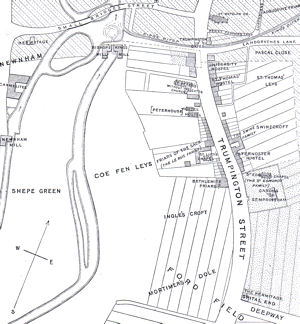
| Plan of Cambridge: outside Trumpington Gates, c. 1270. From Stokes (1908). |
14th century
It was a day's journey from London to Cambridge.
Sources of information: The Victoria History of the Counties of England (1959). The History of
the County of Cambridge & the Isle of Ely. Volume III. The City and University of
Cambridge. City of Cambridge, page 1.
It was a day's journey from London to Cambridge.
Sources of information: The Victoria History of the Counties of England (1959). The History of
the County of Cambridge & the Isle of Ely. Volume III. The City and University of
Cambridge. City of Cambridge, page 1.
11th -14th centuries
The population density of the area to the south of Cambridge was around 35-50 per sq mile at
the time of the Domesday Survey. The population increased up to c. 1300, with the extension
of existing villages and the continued expansion of farmland. The corn trade was a basis for the
prosperity of Cambridge and the surrounding area.
Sources of information: Darby, H.C. (1971). The Domesday Geography of Eastern England.
3rd edition. Cambridge: Cambridge University Press. Pages 5-7, 37-40. The Victoria History of
the Counties of England (1959). The History of the County of Cambridge & the Isle of Ely.
Volume III. The City and University of Cambridge. Medieval Cambridge, page 6 and
Economic History, page 87.
The population density of the area to the south of Cambridge was around 35-50 per sq mile at
the time of the Domesday Survey. The population increased up to c. 1300, with the extension
of existing villages and the continued expansion of farmland. The corn trade was a basis for the
prosperity of Cambridge and the surrounding area.
Sources of information: Darby, H.C. (1971). The Domesday Geography of Eastern England.
3rd edition. Cambridge: Cambridge University Press. Pages 5-7, 37-40. The Victoria History of
the Counties of England (1959). The History of the County of Cambridge & the Isle of Ely.
Volume III. The City and University of Cambridge. Medieval Cambridge, page 6 and
Economic History, page 87.
1210-11
The right to hold Sturbridge Fair [Stourbridge Fair] near the river on the east side of Cambridge
was granted by King John, c. 1210-11. By 1589, it was by far the largest and most famous fair
in England. It was used as a model for Vanity Fair in John Bunyan's Pilgrim's Progress,
published in 1678
Sources of information: Midsummer Common Web site. Darby, H.C. (1971). The Domesday
Geography of Eastern England. 3rd edition. Cambridge: Cambridge University Press. Page 45.
Ridout, Honor (2011). Cambridge and Stourbridge Fair. Cambridge: Blue Ocean. The Victoria
History of the Counties of England (1959). The History of the County of Cambridge & the Isle
of Ely. Volume III. The City and University of Cambridge. Economic History, page 92-95.
The right to hold Sturbridge Fair [Stourbridge Fair] near the river on the east side of Cambridge
was granted by King John, c. 1210-11. By 1589, it was by far the largest and most famous fair
in England. It was used as a model for Vanity Fair in John Bunyan's Pilgrim's Progress,
published in 1678
Sources of information: Midsummer Common Web site. Darby, H.C. (1971). The Domesday
Geography of Eastern England. 3rd edition. Cambridge: Cambridge University Press. Page 45.
Ridout, Honor (2011). Cambridge and Stourbridge Fair. Cambridge: Blue Ocean. The Victoria
History of the Counties of England (1959). The History of the County of Cambridge & the Isle
of Ely. Volume III. The City and University of Cambridge. Economic History, page 92-95.
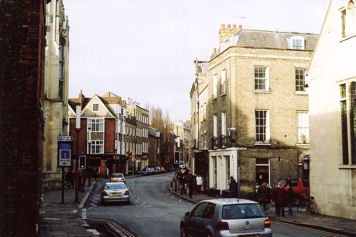
| The junction of Trumpington Street and Pembroke Street, looking towards the location of the Medieval 'Trumpington Gate'. Photo: Andrew Roberts, January 2011. |
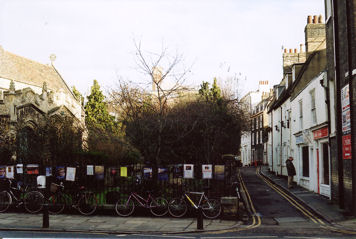
| The churchyard of St Botolph's Church and Botolph Lane from Trumpington Street, the approximate location of the Medieval 'Trumpington Gate' and the line of the King's Ditch. Photo: Andrew Roberts, January 2011. |
Before 1300
The Middle English language evolved out of Old English.
Sources of information: Evolving English: One Language, Many Voices, exhibition at the
British Library, 2010-11.
The Middle English language evolved out of Old English.
Sources of information: Evolving English: One Language, Many Voices, exhibition at the
British Library, 2010-11.
| Timeline pages 1000- 1- 1001- 1501- 1601- 1701- 1801- 1851- 1901- 1951- 2001- 0 BC 1000 AD 1500 1600 1700 1800 1850 1900 1950 2000 present |
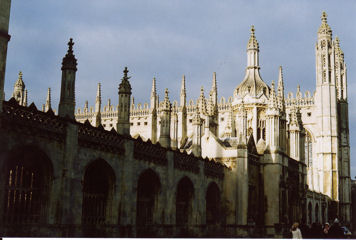
| King's College Chapel and the King's Parade entrance to the college. Photo: Andrew Roberts, January 2011. |
c. 1500
Most of the arable land in south Cambridgeshire was still farmed in open fields, in contrast to the
Midlands where the enclosure movement was active.
Sources of information: Darby, H.C. (1971). The Domesday Geography of Eastern England.
3rd edition. Cambridge: Cambridge University Press. Page 26.
Most of the arable land in south Cambridgeshire was still farmed in open fields, in contrast to the
Midlands where the enclosure movement was active.
Sources of information: Darby, H.C. (1971). The Domesday Geography of Eastern England.
3rd edition. Cambridge: Cambridge University Press. Page 26.
1284-1550
The first of the Cambridge University colleges, Peterhouse, was founded in 1280, followed by
12 other colleges by 1550. The University also developed its central Schools near Cambridge
market. The developments required the clearance of large areas between the market and the
river, to the west of the road to Trumpington.
Sources of information: History of Cambridge University web site [accessed 11 January 2011].
Darby, H.C. (1971). The Domesday Geography of Eastern England. 3rd edition. Cambridge:
Cambridge University Press. Pages 37-40.
The first of the Cambridge University colleges, Peterhouse, was founded in 1280, followed by
12 other colleges by 1550. The University also developed its central Schools near Cambridge
market. The developments required the clearance of large areas between the market and the
river, to the west of the road to Trumpington.
Sources of information: History of Cambridge University web site [accessed 11 January 2011].
Darby, H.C. (1971). The Domesday Geography of Eastern England. 3rd edition. Cambridge:
Cambridge University Press. Pages 37-40.
| Above: The monument to the Trumpington family, Trumpington Church. Photo: Andrew Roberts, October 2011. Below: Brass originally attributed to Sir Roger de Trumpington, illustrated in 1808 for Magna Britannia, Cambridgeshire, facing page 65. |


| The stone base of the former village cross, known as the Stokton Cross, Trumpington Church. Photo: Andrew Roberts, October 2011. |

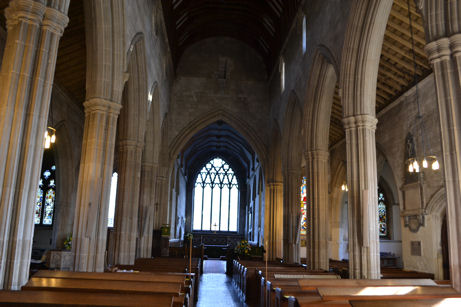
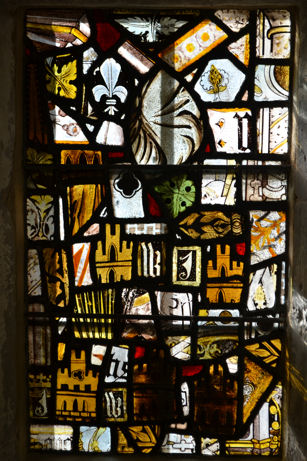
| Medieval glass in a window on the south side of the Chancel. Photo: Andrew Roberts, October 2011. |
| The Nave, Trumpington Church. Photo: Andrew Roberts, October 2011. |

| The base of a pillar dated to c. 1200 AD at the west end of the South Aisle, Trumpington Church. Photo: Andrew Roberts, October 2011. |


| Looking from 'Cross Hill' along Church Lane and up Church Lane towards 'Cross Hill'. Photo: Andrew Roberts, November 2011. |


| Plaque listing rectors and vicars, Trumpington Church. Photo: Andrew Roberts, October 2011. |
1377
The Poll Tax was levied on individuals in 1377, 1379 and 1381. The total liability for Thriplow
Hundred was £24 10s 0d in 1377. The tax was abandoned after the Peasants Revolt in 1381.
Sources of information: Fenwick, Carolyn C. (1998). The Poll Taxes of 1377, 1379 and 1381.
Part 1. Bedfordshire-Leicestershire. Records in Social and Economic History, NS27. Oxford:
University Press for the British Academy. Cambridgeshire, pages 68-71.
The Poll Tax was levied on individuals in 1377, 1379 and 1381. The total liability for Thriplow
Hundred was £24 10s 0d in 1377. The tax was abandoned after the Peasants Revolt in 1381.
Sources of information: Fenwick, Carolyn C. (1998). The Poll Taxes of 1377, 1379 and 1381.
Part 1. Bedfordshire-Leicestershire. Records in Social and Economic History, NS27. Oxford:
University Press for the British Academy. Cambridgeshire, pages 68-71.